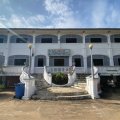NATIONAL COSTUME MUSEUM, FORMER GOVERNOR'S PALACE
Go there and contact
Musée national du costume (National Costume Museum) presenting thematic textile exhibitions such as masks, indigo, ritual costumes..
Converted into the Musée National du Costume in 1981, it was the first headquarters of the Ivory Coast colony, serving as the residence of the first four governors: Louis-Gustave Binger, Eugène Bertin, Louis Mouttet and Henri-Charles Roberdeau. It is assumed that it arrived in prefabricated metal parts in 1893, in the same shipment as the customs posts and post offices of Tabou, Sassandra, San Pedro and Bassam. It was the first iron construction in Grand-Bassam. Its structure consists of metal posts supporting a single storey, surrounded like the first floor by a shaded gallery lined with louvered openings. The original building benefited from an ingenious ventilation system provided by a ridge skylight through which fresh air was drawn in at the base of the building. Shortly after construction, the metal frame was clad with masonry, presumably to protect the structure from marine corrosion, and in 1900, two pavilions were added to the base building, housing sanitary facilities, bathrooms and secondary offices. At the same time, a large terrace was built on the first floor, accessed by a double semicircular staircase. Construction of the palace was completed in 1902 and, despite the transfer of the capital to Bingerville, the governors continued to reside there until 1934.
Today, the museum houses a permanent exhibition on the theme of "Tradition, Costume and Reconciliation", as well as thematic textile exhibitions in collaboration with the Musée des Civilisations d'Abidjan and the Uniwax loincloth house, focusing on the clothing tradition of the Abourés of Moossou, masks, indigo, ritual and ceremonial costumes, basketry and textiles. In the ground-floor room, a succession of costumed mannequins takes center stage: Akan kings richly adorned in gold and dressed in their traditional loincloths, abouré girls and kaolin-coated fetish girls armed with brooms to ward off evil spirits. You'll also come across Krou chiefs dressed in bark, Malinkés dressed for the Kouroubi, the dance of the night of destiny that takes place three days before Ramadan, mysterious stilt dancers from the mountains of the deep West, young women in childbirth, young women who have been circumcised and mystical dozo hunters in ceremonial garb. Upstairs, the former governors' room has become a showroom for the winning costumes of the thematic costume and fashion weeks, during which designers present original works blending tradition and modernity, in an assemblage of composite and natural fabrics, sometimes even made from bark and raffia.
The ground-floor passageways house models of traditional housing from the various regions of Côte d'Ivoire, and various photographs show us the ritual celebrations associated with these regions, as well as the different stages of French colonization. In the adjoining room, you'll find the period bathroom and the "Binger sideboard", a piece of furniture from his time. You'll also need to find the "cachette" set up for emergencies, and in the garden, a small abandoned building where questions of common law were settled between natives and colonists. Guidebook recommended, as signage is non-existent.
Did you know? This review was written by our professional authors.
Book the Best Activities with Get Your Guide
Members' reviews on NATIONAL COSTUME MUSEUM, FORMER GOVERNOR'S PALACE
The ratings and reviews below reflect the subjective opinions of members and not the opinion of The Little Witty.
Find unique holiday offers with our partners






